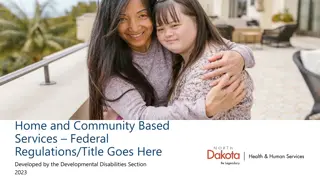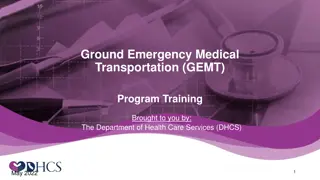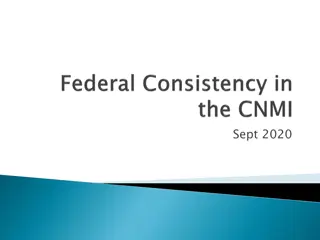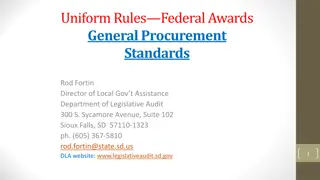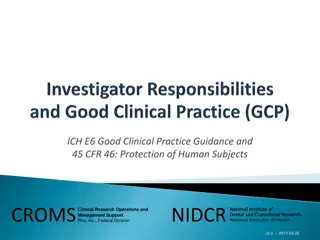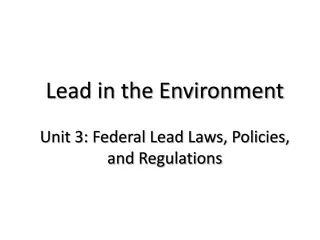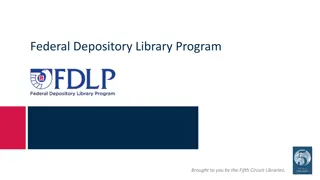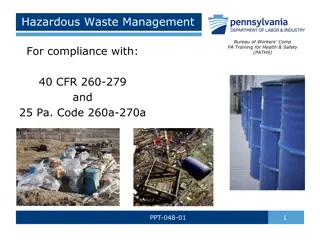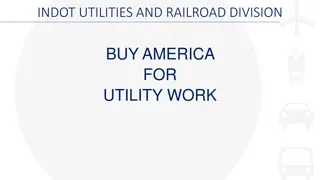Understanding Home and Community Based Services Federal Regulations
Home and Community Based Services Federal Regulations are developed to ensure individuals have full access to community living with maximum choice and control over their lives. Compliance with CMS rules is necessary to receive funding for waiver services. The regulations aim to integrate individuals into the community, provide meaningful activities, and respect their rights.
Download Presentation

Please find below an Image/Link to download the presentation.
The content on the website is provided AS IS for your information and personal use only. It may not be sold, licensed, or shared on other websites without obtaining consent from the author. Download presentation by click this link. If you encounter any issues during the download, it is possible that the publisher has removed the file from their server.
E N D
Presentation Transcript
Home and Community Based Services Federal Regulations Developed by the North Dakota Department of Human Services, Developmental Disabilities Division 2019
Where do the rules come from? The Centers for Medicare and Medicaid Services (CMS) is a part of the federal government that oversees the federal funding used to pay for Home and Community Based waiver services. States and providers are required to follow federal regulations in order to receive funding. 2
What does this mean for people we support? People have full access to the benefits of community living based on characteristics and individual experiences. People have the opportunity to receive service in the most integrated settings. People have maximum choice and control over their livesmaking big and small life decisions. Rights are respected and should be same as any citizen. 3
Exploring Aspects of HCBS Video https://c-q-l.org/resource-library/resource-library/all- resources/hcbs-settings-rule-approaching-the-original- deadline CMS probes and questions to ensure compliance: http://www.nd.gov/dhs/services/disabilities/docs/2015- cms-requirements-for-hcbs.pdf Acknowledgements: Resources from CMS and CQL were used in putting together this presentation. 5
Settings Any setting where home and community based services are provided Residential group home, apartment Non Residential work, day program Private home- living with family, relative, or primary caregiver Home and community based CANNOT be in Nursing facility Institution for mental diseases ICF/IID Hospital A setting that is isolated from the broader community A setting that has institutional characteristics (i.e. setting is not individualized to people s preferences) 6
#1- The setting is integrated in the greater community AND supports full access to the greater community. People live in neighborhoods and work with people with out disabilities. People are supported to participate in their community. Opportunity to get paid at least minimum wage. Control their own money. Engage in meaningful age appropriate activities. Home is accessible to meet their needs. 7
#2- The setting is selected from options that include people without disabilities. People have choice of roommate or live alone. People have choice of having own bedroom. Choice of available living options and opportunities to visit. Options in day activities including competitive employment, volunteering, etc. Setting choices reflect peoples needs and preferences. 8
#3- Setting must ensure peoples rights are respected and promoted. Have privacy can be alone or spend time with other people. Are treated with dignity and respect-do things that are important that person. People are treated as people first. Can make own decisions without being coerced or forced to do what don t want to do. Have the right to be free from restraint being held against will or kept from doing something you want. Setting doesn t prevent people from coming and going. 9
#3- Setting must ensure peoples rights are respected and promoted. People can lock and have a key to their own front door. Choosing how to decorate and furnish their room or house. People have access to food at any time i.e. snacks through out the day, food/drink when they want it. People have visitors at any time. People have access to their personal items i.e. TV, radio, computer, phone 10
#4- The setting encourages: Individual initiative Telling people what you want, and deciding to do things on your own. Autonomy Doing things on own as much as possible. Independence in making life choices What do each day; choice in when go to bed, eat, do activities, work schedule, breaks at work, etc. Where live, work, or spend time. Who talk with. 11
#5- The setting provides choice about services/supports and who provides them. Select the services received and providers of those services. Opportunity to update, change preferences, and request a new provider. Active roll in the development and updates of their plan. Choice among community services (pharmacy, doctors, grocery store, salon, bank, etc.) 12
This does not mean: Only go into the community with a group as a group trip or outing. Entire day spent at day program location. All activities are scheduled by staff with out individual input. Can only shower on certain days or times. If chores not done, no other activities that day. Schedules are posted. No area to make private phone calls or have to ask to use the phone. Staff talking about you in front of others. Scheduled meal, bed, & waking times. Set menus and people are not part of the meal planning No food in bedrooms. All checkbooks kept in staff office. Not permitted in certain parts of home. Does not have own key to bedroom/house. Home is decorated/furnished by provider only. House rules. Being told can only make changes at annual meeting. 13
#6- Additional conditions for residential settings that are owned or controlled by a provider. Provider owned or controlled setting: Group home or apartment owned or run by a service provider Each person must have a lease Same responsibilities and protections from eviction as all tenants under ND landlord tenant law Should not contain- house rules, visitor restrictions, access to food, etc. People must have lockable bedroom doors Staff can have keys but person s plan identifies circumstances for use Applies if someone lives alone If not wanted by person must be addressed in plan If unable to have a lock, it is considered a rights restriction 14
#7- If extra support is needed to maintain health and safety. People may not be able to take part in all of the freedoms the regulations provide. (i.e. Person has food locked up due to health and safety.) When that happens the provider has very strict rules they have to follow and document: Base the restriction on a specific individual need. Show that positive interventions have been tried but haven t worked. Keep measuring with data collection to determine if restriction should continue. Show that any modification is TEMPORARY and includes a fading plan. Informed consent from person and legal decision maker. Show the intervention will cause no harm. 15
How provider staff ensure compliance Self-assessment captures individual experiences to ensure the regulations are met. Implement practices and procedures that are aligned with the regulation. Utilize person centered service planning processes. Maintain CQL accreditation and utilize the personal outcome measures. Initial orientation and annual training for staff. Initial setting review for new provider-owned residential or facility-based day program prior to setting being initiated, built or purchased 16
How DDPM/PAs ensure compliance Environmental Scan to monitor physical environment and locked doors. If person is not satisfied with living, work, other services, or provider, they will help find other options. Review self-assessmentto ensure people s outcomes are being realized. Approve plans that are developed according to peoples needs and preferences in line with regulations. Conduct face to face visits to monitor service satisfaction and plan implementation. Review future provider owned or controlled settings and facility based day programs. 17
How the State Office ensures compliance HCBS Provider Survey Initial training for DDPMs and New Providers Annual training for DDPMs Review future provider owned or controlled settings and facility based day programs. Review provider policy and procedures for licensure (initially and annually as updated) Quality assurance reviews of provider and DDPM activities. Heightened Scrutiny review for settings potentially institution and/or isolating in nature. 18
Resources For further detail, instructions, & resources visit: http://www.nd.gov/dhs/services/disabilities/dd- hcbs.html Regulations also apply to person-centered service planning requirements and are incorporated into the Overall Service Plan (OSP) Instructions: http://www.nd.gov/dhs/services/disabilities/docs/overall- service-plan-instructions-update.pdf 19
Further Questions? Contact the Developmental Disabilities Division 1237 W. Divide Ave., Suite 1A Bismarck, ND 58501-1208 Phone: 701.328.8930 Toll Free: 800.755.8529 E-mail: dhsddreq@nd.gov 20



